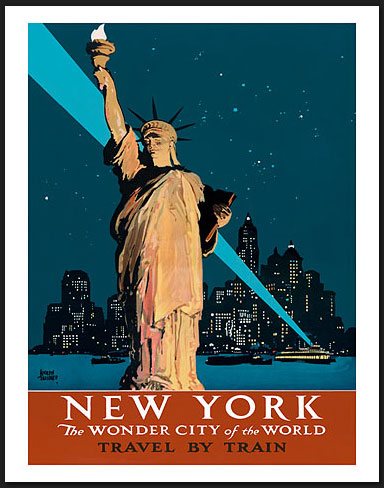The History of Poster Art over the last two Centuries. Part 5
Today we are continuing with our ongoing exploration of the History of Poster Art as it evolved over the last two centuries.
In Parts 1-4 of this Blog we commented on the early history of the poster since the late 1800’s. French artists that worked during the “Belle Epoque” deserve credit for developing this new art form, in particular the works of “the father of the poster”, Jules Chéret and his publication “Maitres de l’Affiche”.
We also introduced a number of important artists of the era and their creations, Mucha, Toulouse-Lautrec, Cappiello, Grasset, Steinlen and Rhead. Today we “follow” Rhead to the US where poster art was still in infancy.
Louis John Rhead (1857–1926)
Louis John Rhead was an English-born American artist who emigrated to the United States at the age of twenty-four and had great influence on American poster designers.
In the United States, posters had not evolved to the same artistic level as in Europe. American posters were primarily directed towards basic commercial needs to deliver a written message.
However, the new influences from Europe and the advent of the travelling circus brought colorful posters to tell citizens that a carnival was coming to town.

Ringling Bros. and Barnum & Bailey, ca. 1900
But many of these too were very commercially utilitarian, of average quality, and only a few saw any real artistic creativity.

Al G. Barnes Circus, ca. 1900’s
This changed in the 1920’s and 1930’s when many posters appeared that had great artistic merit and have become extremely collectible. These include the posters advertising World’s Fairs and Colonial Exhibitions.

Travel posters
With the advent of the industrial revolution, travel by train, plane and bus gave rise to tourism and posters promoting travel destinations. Tourist Offices, airlines, railroad and bus companies commissioned artists to promote their business.

In the next few Blogs we will introduce some highlights of Travel & Tourism posters that were designed by talented artists. This new art form was popular until the 1960’s when photography took the place of graphic art.
 Pan American World Airways, commonly known as Pan Am was the principal and largest international air carrier in the United States from 1927 until its collapse on December 4, 1991. Founded in 1927 as a scheduled air mail and passenger service operating between Key West, Florida, and Havana, Cuba, the airline became a major company credited with many innovations that shaped the international airline industry.
Pan American World Airways, commonly known as Pan Am was the principal and largest international air carrier in the United States from 1927 until its collapse on December 4, 1991. Founded in 1927 as a scheduled air mail and passenger service operating between Key West, Florida, and Havana, Cuba, the airline became a major company credited with many innovations that shaped the international airline industry.
Identified by its blue globe logo, the use of the word “Clipper” in aircraft names and call signs, and the white pilot uniform caps, the airline was a cultural icon of the 20th century. In an era dominated by flag carriers that were wholly or majority government-owned, it was also the unofficial flag carrier of the United States.
Pan Am was one of the first airline companies to use posters in promoting the travel destinations the carrier serviced. During the early era of tourism also dubbed “The Golden Age of Travel” Pan Am commissioned such artists as Paul George Lawler, Mark von Arenburg, Ivar Gull and others to design posters for the routes of the famous Clipper Ships.
These posters are now highly collectible and are being auctioned by Christie’s, Swann Galleries and other such establishments and fetch high prices.

Fly to South Sea Isles, Paul George Lawler, ca. 1940’s

Fly to Europe by Clipper, Mark von Arenburg, ca. 1940’s

Norway, Land of the Midnight Sun; Ivor Gull, ca. 1930’s
To be continued… to view further works by these poster artists, please visit our web sites: classicvintageposters.com and islandartstore.com. Thank you for your interest in these blogs, your feedback is appreciated.
Bernard Lassalle bernard@classicvintageposters.com